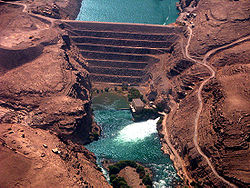Kajaki Dam
| Kajakai Dam | |
|---|---|

Aerial view of the Kajaki Dam in 2004
|
|
| Country | Afghanistan |
| Location | Kajaki District, Helmand Province |
| Coordinates | 32°19′19″N 65°7′8″E / 32.32194°N 65.11889°ECoordinates: 32°19′19″N 65°7′8″E / 32.32194°N 65.11889°E |
| Purpose | Irrigation and electricity |
| Status | Operational |
| Construction began | 1951 |
| Opening date | 1953 |
| Owner(s) | Afghan Ministry of Energy and Water |
| Dam and spillways | |
| Impounds | Helmand River |
| Height | 100 m (328 ft) |
| Length | 270 m (886 ft) |
| Reservoir | |
| Total capacity | 1,715×106 m3 (1,390,373 acre·ft) |
| Active capacity | 1,134×106 m3 (919,349 acre·ft) |
| Power station | |
| Operator(s) | Helmand and Arghandab Valley Authority (HAVA) |
| Commission date | 1975 |
| Turbines | 2 x 16.5 MW Francis-type |
| Installed capacity | 33 MW |
The Kajakai Dam is one of the two major hydroelectric power dams of Helmand province in southern Afghanistan. The dam is located on the Helmand River 100 miles (161 km) north-west of Kandahar and is operated by the Helmand and Arghandab Valley Authority. It has a dual function, to provide electricity and to irrigate some 650,000 acres (1800 km²) of an otherwise arid land. Water discharging from the dam traverses some 300 miles (500 km) of downstream irrigation canals feeding farmland. It currently produces 33 megawatts of electricity.
The dam is 100 m (328 ft) high and 270 m (890 ft) long, with a gross storage capacity of 1,715,000,000 m3 (1,390,373 acre·ft) of water. The dam controls the output of the main watershed which feeds the Sistan Basin.
Final studies for the dam began in 1946 and a preliminary design was crafted in 1950. The dam was built between 1951 and 1953 by the Morrison-Knudsen firm as part of the Helmand Valley Authority project.
In 1975, USAID commissioned the initial installation of two 16.5 MW generating units in a powerhouse constructed at the toe of the dam. This first stage powerhouse was actually constructed to house three equally sized units. Only units 1 and 3 were installed originally.
When the Soviets invaded Afghanistan in 1979 the contractors left. They had intended to raise the dam by 2 meters in order to increase the available water for power production and irrigation. They were also excavating an emergency spillway which was never completed. Gates were also never installed in the service spillway so the dam passes all water in the reservoir above elevation 1033.5 meters. Completion of the spillway gates would increase the total storage capacity of the reservoir by 1,010,000,000 m3 (818,820 acre·ft) to 2,725,000,000 m3 (2,209,193 acre·ft).
...
Wikipedia
